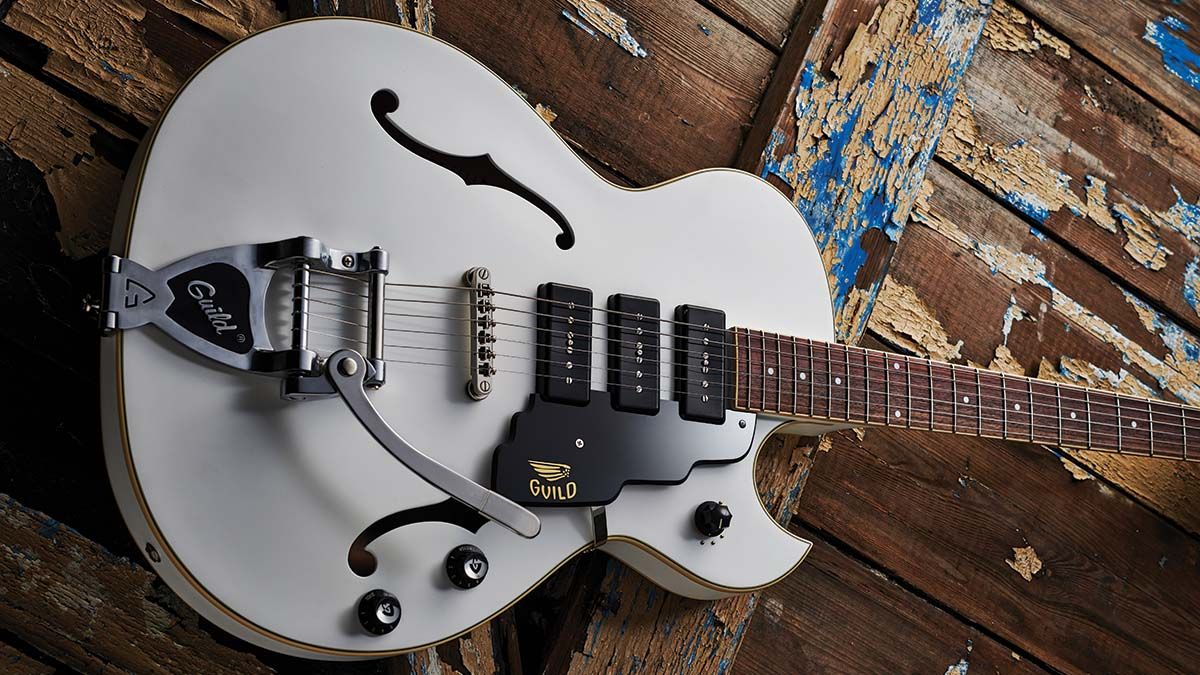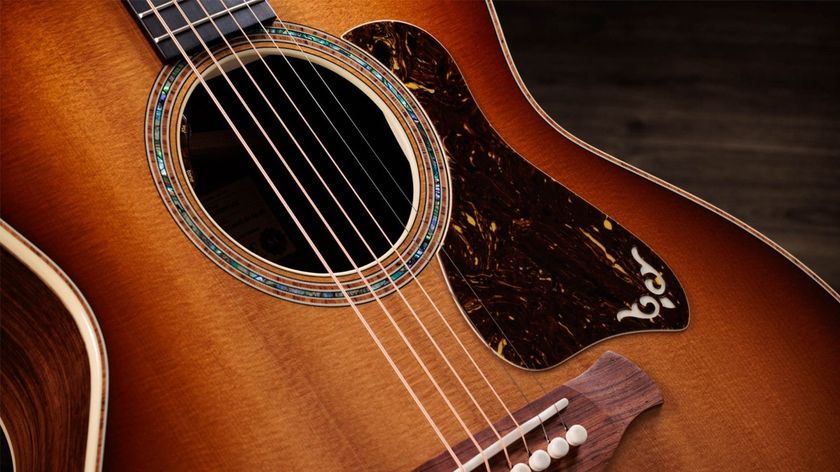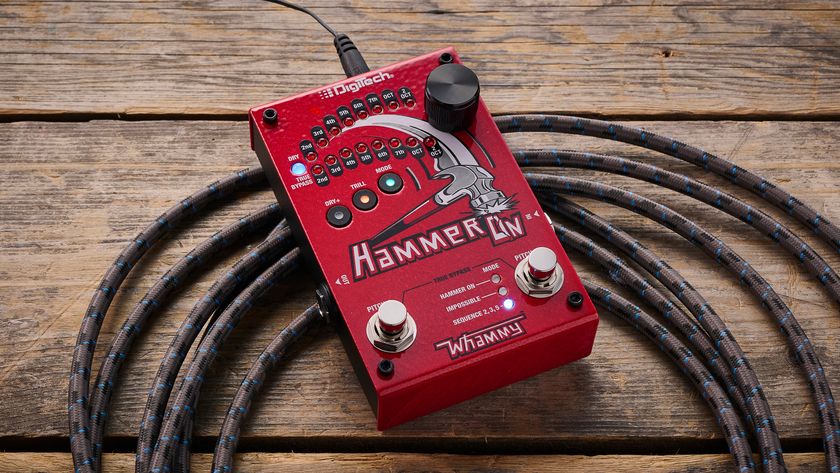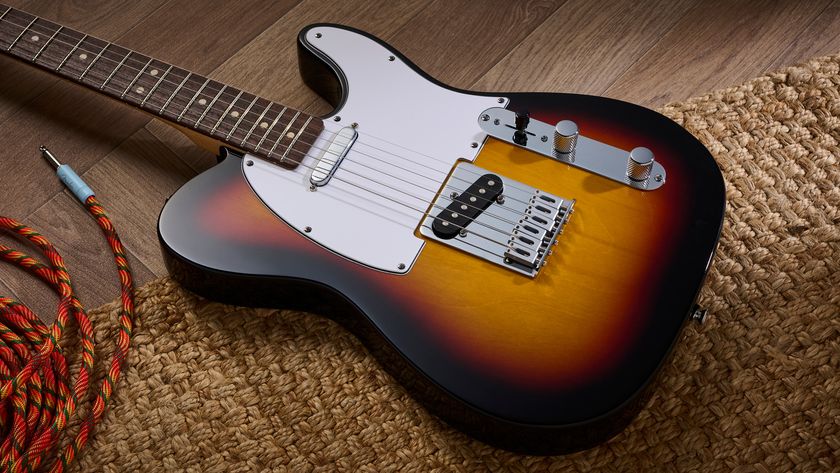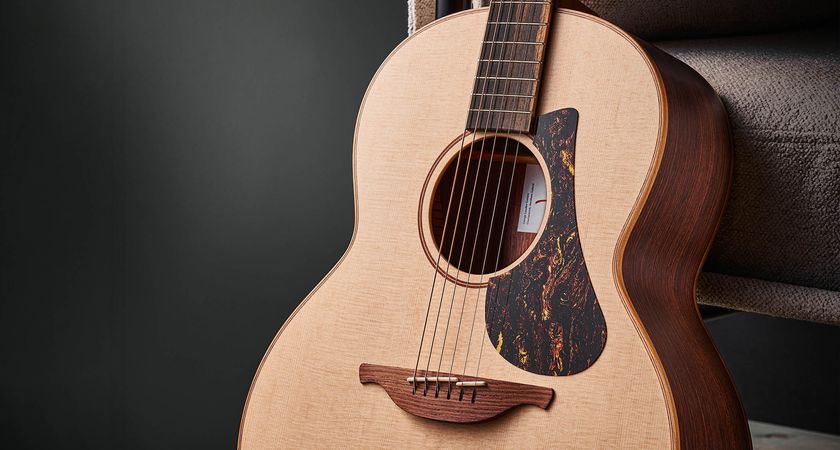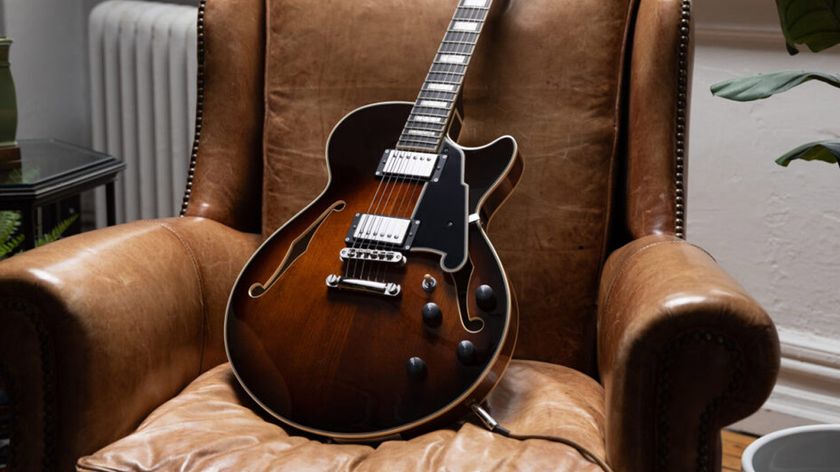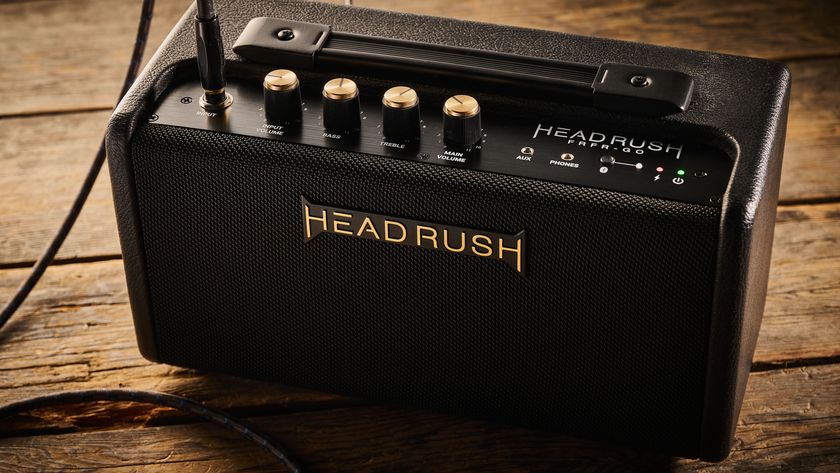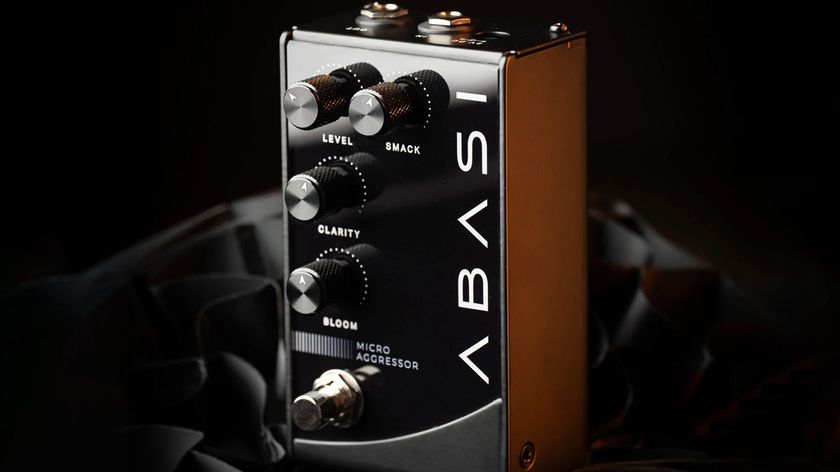Guitar World Verdict
A bona-fide Concorde among semis, the Jet90 is a super-fun, super-cool option for all manner of P-90-based shenanigans. Country, rock, blues – you name it. And at this price, it takes no huge investment to get your wings.
Pros
- +
Credible build.
- +
Great Sustain and good sounds.
- +
We like the headstock, too!
Cons
- -
A chubbier neck would be nice for many.
- -
Needs a tougher spring in the vibrato.
You can trust Guitar World
If we were grading on looks alone, the new Guild Starfire I Jet90 would bag a 10 without breaking a sweat. The Jet90 plays fast and loose with Guild’s heritage, probably best described as a bit of a mash-up.
Back in issue 465 we looked at the new Starfire I DC and SC models, and here Guild has taken the single-cut SC body with its sharp Florentine and melded the Firebird-esque headstock from its Jetstar solidbodies.
Six-in-line headstocks on semis just look cool, don’t they? Anyone remember the Hagström Viking II Elvis played on his ’68 Comeback Special TV show? Then there’s the cult classic Gibson Trini Lopez, a guitar that’s probably better known these days by its association with Foo Fighter Dave Grohl.
While the Indonesian-built Jet90 boasts that pimped silhouette, construction-wise, this apple hasn’t fallen far from the family tree. The lightly arched ABS plastic bound body is pressed from sheets of laminate maple and finished in satin polyurethane. This guitar is semi-solid and here, like the Gibson ES-335, we have a mahogany centre block that’s also chambered to prevent excess baggage.
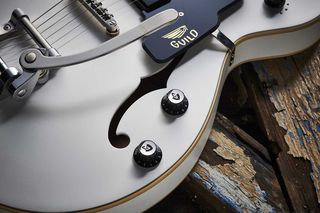
The unbound f-holes look just right and reveal this guitar’s vintage-spec thin laminate maple top. That should make for great resonance when we start whacking the Jet90 with our right hand.
We love the cute trademark silver-topped and logo’d Guild control knobs, not to mention the Art Deco stepped scratchplate. The lightweight aluminium Guild-logo’d Bigsby-style vibrato and anchored tune-o-matic bridge look killer, too. The Jet90 comes loaded with a trio of Franz P90 single coils.
Now long deceased, Franz was a manufacturer based in Astoria, New York, that began supplying P-90-style pickups to Guild back in the 1950s. Renowned more for their tone than their crude construction, original Franz pups are now highly sought after. So much so, in fact, that premium winders such as Seymour Duncan and Curtis Novak have met demand with replicas.
The pickups are wired to a master volume, master tone and a six-position rotary switch. We love this throwback to 50s Guilds, especially the little metal studs set around the switch to mark its half dozen positions.


That said, when we eventually get back to playing on darkened stages, it might be tough to figure out what pickup setting you’re on. You might find yourself feeling for clicks like a safe cracking villain on an episode of The Sweeney.
Moving on, the satin polyurethane coated set mahogany neck features a self-explanatory Modern Thin ‘U’ profile, and an Indian rosewood fingerboard with 20 narrow tall frets and a radius of 320mm (12.5 inches). The fingerboard is bound with the same thermoplastic polymer as the body, and comes signposted with 5mm wide dot inlays.
The Jet90’s 43mm wide top nut is made from a composite plastic material and the story continues with an Art Deco shield-style truss rod cavity cover and the Guild logo. Flip the guitar over and you’ll encounter a conspicuous volute as the neck transitions into that beautiful headstock. You’ll also come face to face with a set of old-school Kluson-style tuners that feel a bit flimsy to us.
A couple of them already feel loose and a bit imprecise. We get that this guitar offers serious value for money, but a set of more robust pegs, Grover Mini Rotomatics, for example, would add a few more spoonfuls of sugar to an already sweet deal.
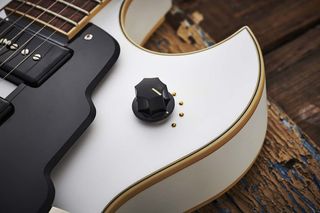
Feel & Sounds
Guild gave it to us straight. The Jet90’s neck feels thin. The good news is that it’s not shredder-spec, lollipop-stick slim. We’ll take a chunky monkey neck all day long, yet we got on with the Jet90’s profile like we were old pals.
The low action and well-sorted frets did nothing to sour the bonding process. The only fly doing the backstroke in our ointment was the clunky feeling vibrato; there’s not enough resistance from the spring as you’re pushing the vibrato arm down. An uprated coil could make everything all right.
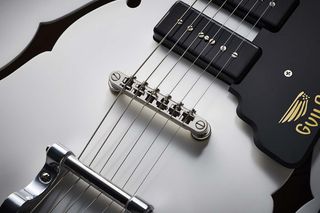
Whammy issues aside, tuning stability on the Jet90 is impressive. That’s one of the major benefits of a six-in-line headstock format. The strings follow a straight path from top nut to tuner. There’s less chance they’ll get stuck in their slots if the nut is well cut. If you’re one of those deluded souls labouring under the misapprehension that the ’69 moon landings were the greatest event of the 20th century… nope.
The fall of the Berlin Wall? Not even close. The answer you’re looking for is that moment someone first screwed a P-90 pickup to a chunk of mahogany. Granted, the Jet90 is surrounded by a crisp laminate maple shell and that plays its part in setting this guitar’s tonal store out.
That said, it’s that chambered mahogany centre block that’s doing the bulk of the heavy lifting in the tone and humongous sustain departments in our opinion. Case in point is position 1 on the six-position rotary switch: the bridge pickup running solo. It’s bright and punchy as you’d expect from a P-90 and yet there’s an underlying warmth to it.
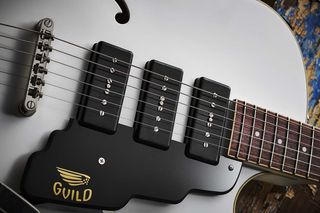
The fact that it maintains some distance from the bridge helps account for some of the girth, we reckon. That response is echoed in the other positions to increasing degrees as you click through the switch. Position 2 is the bridge and middle pups in cahoots, in hum-cancelling mode.
Next up, you get the middle pickup solo before position 4 adds in the neck pickup. Position 5 features the neck pickup – all very Strat-like – while, finally, in position 6 we get the bridge and neck pickups conspiring together in hum-cancelling fashion.
Original 50s Franz single coils have an output of 4.6k to 4.9kohms and are known for a pronounced top-end. The updated pickups here come in at just a hair under 7k. These things are well balanced, widening their appeal. Blues and rock nuts will enjoy the ballsy bridge pickup, especially with some righteous overdrive.
Likewise, the super-fat Strat vibe of positions 2 and 4. The bridge and neck combo will please rockabilly and country types. To be clear, aside from metalheads, who likely don’t hold a candle for P-90s anyway, these modern Franz pups should put a smile on a lot of faces.
Verdict
One of the saddest moments in guitar history was when then owner Fender closed down Guild’s Westerly, Rhode Island, factory in 2001. This writer had the good fortune to visit the plant a few years before its doors were closed for good and it was an unforgettable experience. The place couldn’t have felt more old-school if the workers turned up for their shifts on Penny Farthings.
While it’s bittersweet, in terms of its electric guitars, that Guild exists only as a brand name on Asian-sourced instruments these days, the Jet90 proves that the brand’s legacy is in safe hands under the current ownership of the Córdoba Music Group.
This guitar couldn’t look cooler if it were chiselled out of ice
Like the Starfire I DC and SC guitars we reviewed last year, not to mention the Aristocrat P90 and HH models, the Jet90 really punches above its price point at just about every turn. Yes, the vibrato on our review guitar could do with a tweak, but the build quality, playability and sounds on offer at this price make it hard to grimace.
Then there’s that kerb appeal. This guitar couldn’t look cooler if it were chiselled out of ice. In fact, while there are plenty of affordable semis out there, all vying for your attention and credit card details, few can match the beauty of that artfully sculpted protrusion at the end of this Starfire’s neck.
Our advice? Call us complimentary nuts, but we recommend you fly Jet90. You might just find it beats the competition. By a head.
Specs
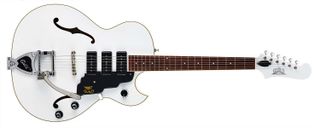
- PRICE: $649 / £599
- ORIGIN: Indonesia
- TYPE: Single-cutaway semi-acoustic thinline electric guitar
- BODY: Laminated maple with chambered mahogany centre block, ABS binding, satin polyurethane finish
- NECK: Mahogany with satin polyurethane finish, set-in
- SCALE LENGTH: 629mm (24.75”)
- NUT/WIDTH: Composite/43mm
- FINGERBOARD: Indian rosewood with ABS binding and 5mm pearloid dot inlays, 320mm (12.5”) radius
- FRETS: 20, narrow tall
- HARDWARE: Nickel tune-o-matic anchored 6-saddle bridge and aluminium Guild Bigsby style vibrato, vintage-style inline tuners
- STRING SPACING, BRIDGE: 52mm
- ELECTRICS: 3x Guild Franz P90 Soapbar single coils, master volume, master tone, 6-way pickup selector rotary switch
- WEIGHT (kg/lb): 3.3/7.5
- OPTIONS: None
- RANGE OPTIONS: The Starfire I SC and DC models come with or without Bigsby at £459 and £549 respectively. The more historically correct Starfires include the single-cut III at £1,090
- LEFT-HANDERS: No, but the Starfire IV ST Lefty double-cut hardtail in Black is available at £819
- FINISHES: Satin White (as reviewed), Satin Black, Satin Gold
- CONTACT: Guild
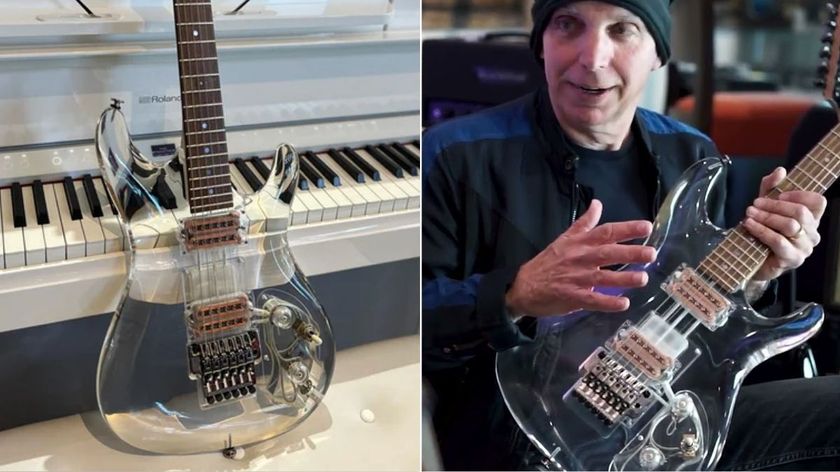
“When I saw it, I couldn’t believe how cool it was”: Joe Satriani is selling one of his rarest guitars – an ultra-ambitious Ibanez Y2K Crystal Planet prototype

“They’re basically Les Paul copies, let’s be frank. It’s a Les Paul-style guitar and I already have amazing Les Pauls”: Kirk Hammett owns over 100 guitars but none of them are PRS. He explains why
